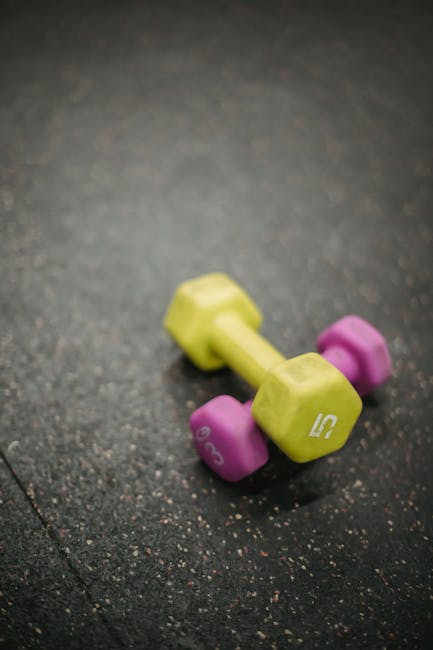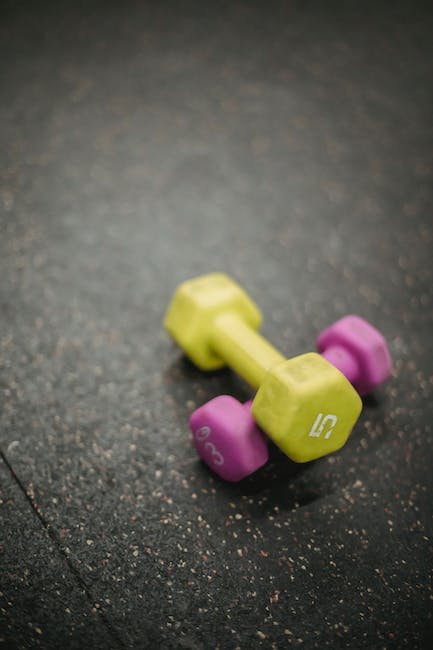Ladies and gentlemen, boys and girls, gather ’round as we delve into the mystical world of weight lifting straps. Ah yes, the humble weight lifting strap – an innocent-looking piece of equipment, yet capable of lifting mountains (figuratively speaking, of course). But if you’re anything like me, the thought of using these things can be somewhat daunting. Fear not, my fellow lifting enthusiasts, for we are about to embark upon a journey of enlightenment – a journey that will teach us the proper technique for mastering weight lifting straps. Not only will you be able to lift heavier weights, but you’ll look darn cool doing it too. So grab your straps, and let’s get ready to rock and roll!
Contents
- 1 1. Introduction: The Importance of Proper Weight Lifting Strap Technique
- 2 2. Understanding the Different Types of Weight Lifting Straps and When to Use Them
- 3 3. Step-by-Step Guide to Properly Apply and Tighten Weight Lifting Straps
- 4 4. Common Mistakes to Avoid in Using Weight Lifting Straps
- 5 5. Benefits of Mastering Proper Weight Lifting Strap Technique for Enhanced Performance
1. Introduction: The Importance of Proper Weight Lifting Strap Technique
We all know what it’s like to feel like a superhero in the gym: lifting impossibly heavy weights, grunting like a savage animal, and feeling that sweet burn in our muscles. But let’s be real, lifting without the proper technique is like trying to drive a car without knowing how to use the brakes. Sure, you might feel cool for a few seconds, but you’re going to crash and burn sooner or later.
That’s where weight lifting straps come in, the unsung heroes of the gym world. With the right technique, these bad boys can take your lifting game to the next level. So, let’s get down to business and talk about how to properly use weight lifting straps, because let’s face it, nobody wants to be the dude who accidentally flings a dumbbell across the gym.
First things first, make sure you’re using the right kind of strap for the exercise you’re doing. There are a few different types of lifting straps out there, including figure-eight straps, traditional straps, and hook grip straps, just to name a few. Do your research and figure out which straps are best suited for your specific exercise. And remember, just like how Batman has different gadgets for different scenarios, you too need different straps for different lifts. So don’t be afraid to mix and match, just like you would with your wardrobe.
Next, make sure you’re properly adjusting the straps to fit your hands. You want them to be snug, but not too tight, and you definitely don’t want them slipping mid-lift. A common mistake is not wrapping the strap all the way around your wrist, which can cause irritation and discomfort over time. So, when in doubt, wrap it all the way around and give it a good tug to make sure it’s secure. The last thing you want is to drop a 100-pound weight on your foot because your strap slipped. Trust us, it’s not a good time.
2. Understanding the Different Types of Weight Lifting Straps and When to Use Them
In the world of weightlifting accessories, straps are the unsung heroes. They’re not as flashy as a shiny new pair of lifting gloves or as sleek as a set of headphones, but trust me when I say they’ll do wonders for your grip. But not all straps are created equal and knowing which one to use when can make a huge difference in your lifting game.
First up, we’ve got the classic wrist strap. You know the one, it’s a simple loop that you tighten around your wrist and then wrap around the bar for a secure grip. This trusty tool is great for heavy deadlifts or rows where grip strength is crucial. Plus, they come in all kinds of colors and patterns so you can match them to your gym outfit and feel fierce.
If you’re looking for a bit more support, then the figure-eight strap might be right up your alley. This bad boy literally looks like a figure-eight (shocker, I know) and gives you added stability for your lifts. They work best for barbell shrugs or other exercises where you need to hold onto the weight for a longer period of time. Just don’t blame us if you end up looking like you’ve got two bow ties on your wrists.
Last but not least, we have the hook strap. This one is for all you folks who have trouble with grip strength or suffer from wrist pain. The hook design takes some of the load off your hands and allows you to focus on the movement. They’re great for lat pulldowns or heavy rows, and while they may look a bit intimidating at first, trust us, they’ll make your lifting journey a whole lot easier.
So, there you have it folks. Three types of weight lifting straps for all your grip-strengthening needs. Just remember to use them appropriately and always be safe in the gym. Happy lifting!
3. Step-by-Step Guide to Properly Apply and Tighten Weight Lifting Straps
First things first, let’s get one thing straight: weight lifting straps are not headbands. If you’re using them for anything other than weight lifting, please take them off now and back away slowly. We don’t need any accidents happening on our watch.
Assuming you’re using your weight lifting straps for their proper purpose, let’s dive into the step-by-step guide for properly applying and tightening them.
1. Pull the strap through the loop at the end of the weightlifting glove.
2. Wrap the strap around the bar, making sure it’s snug but not too tight.
3. Twist the strap and loop it over itself, creating a secure lock. Don’t worry if it takes you a couple of tries to get this part right – we won’t judge you.
Now that you’ve got your straps on, it’s time to tighten them up. But beware, the following steps are not for the faint of heart. If you’re prone to sweating bullets at the thought of tightening something, you may want to call in backup.
1. Extend your arms and grip the bar as tightly as possible.
2. Slowly lift the weight off the ground, ensuring that the strap remains tight the whole time.
3. Before you know it, you’ll be standing there with the weight lifted and your straps nice and snug. And if you’re feeling particularly strong, feel free to let out a primal roar. We won’t tell.
4. Common Mistakes to Avoid in Using Weight Lifting Straps
So, you think you’re ready to use weight lifting straps? You’ve read up on how they work, and you’re ready to start hauling some iron? Well, hold your horses there, turbo. Before you strap yourself in and start lifting like you’re Arnold Schwarzenegger in his prime, there are a few common mistakes you need to avoid. Because just like any workout routine, using lifting straps can be dangerous if you don’t do it right. But don’t worry, we’ve got you covered. Here are some common mistakes you should avoid when using weight lifting straps:
-
Using straps too soon
You might think that lifting straps are the perfect solution to your weak grip, but let us tell you something – weight lifting is about strength, not just looking strong. If you’re using straps to avoid working on your grip strength, you’re cheating yourself out of some major gains. Start with lighter weights and gradually build up your grip strength, then gradually add lifting straps to your routine.
-
Wrapping the straps around your wrists too tight
Okay, we get it. You’re trying to lift as much weight as possible. But if you wrap those straps around your wrists too tight, you’re going to cut off your circulation, and nobody wants to lose a limb to weightlifting. Leave a little bit of slack, so your fingers can still move, and you won’t turn into a human tourniquet.
-
Using straps for every lift
We know lifting straps can be tempting, especially when you feel like you’re not making progress with certain exercises. But please, resist the urge to use lifting straps for every lift. You need to work on your grip strength, and that means ditching the straps every now and then. Plus, you don’t want to be that guy who can deadlift a car but can’t carry his groceries without his straps.
5. Benefits of Mastering Proper Weight Lifting Strap Technique for Enhanced Performance
So, you’ve finally decided to join the gym to work on your upper body muscles and get rid of that stubborn arm flab, huh? Well, congratulations on taking the first step towards becoming a fit and healthy version of yourself! But, wait, before you start bench-pressing those monstrous weights that only the Hulk can lift, let’s talk about the importance of mastering proper weight lifting strap technique for enhanced performance.
- Improved Grip Strength: One of the biggest benefits of wearing weight lifting straps is that they help you get a better grip on those heavyweights, thereby reducing your risk of slipping or injuring yourself. By using weight lifting straps, you can focus on lifting the weight with your target muscles – rather than worrying about your grip – which ultimately leads to enhanced performance.
- Increased Repetitions: Another major advantage of mastering the proper weight lifting strap technique is that they allow you to lift heavier weights with ease, which means you can perform more repetitions of each exercise. As a result, you will see faster results and be able to take your workouts to the next level.
- Less Strain on Forearms: Ever experienced forearm fatigue when lifting heavy weights? We know the feeling. By wearing weight lifting straps, you can reduce the pressure on your forearms and focus on the targeted muscle groups, leading to a more effective workout without compromising safety.
So, there you have it, folks – the top three benefits of mastering proper weight lifting strap technique for enhanced performance. We hope this article has convinced you to add weight lifting straps to your gym bag the next time you hit the weights. And until then, keep lifting, keep sweating, and keep smiling!
Don’t Get Strapped Up in Confusion
Congratulations, you’ve made it to the end of our weight lifting straps article! By now, you should have all the knowledge you need to use these handy tools with proper form and technique.
Just remember, using lifting straps won’t magically turn you into the Incredible Hulk (although we wish it would too). It’s still important to keep working hard and pushing yourself during every training session.
So go forth, be strong, and keep on lifting. And, hey, if you happen to forget how to use those straps, just come back and read this article again. We’ll be here with our puns and jokes ready to help you out.








Leave A Comment